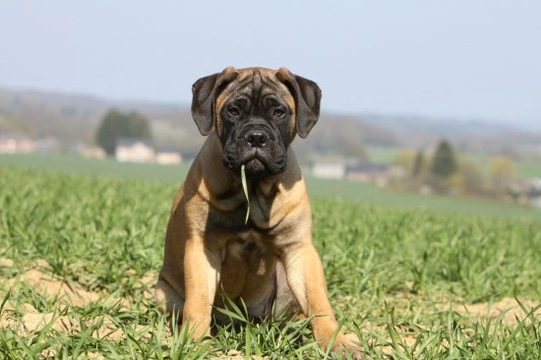Pets
Pets for studWanted petsBreedersAccessories & services
Knowledge hub
Support
Support & safety portal
Bullmastiff health and temperament
The Bullmastiff is classed as a large breed dog, and you will certainly see them coming from some distance away! They have a solid build, are relatively tall, and look as if they mean business with their alert, watchful demeanours and bright temperaments.
They are also one of the native English dog breeds, first being recognised by The Kennel Club in 1924. They are renowned for having strong guarding instincts, and for being rather territorial and protective of their families. If you are considering buying or adopting a Bullmastiff dog or puppy, read on to learn more about some of the breed’s basics, including their general health, temperament and trainability.
The Bullmastiff’s working history
The Bullmastiff was traditionally bred by gamekeepers on large estates to assist with the tasks of guarding the estate, and offering protection to gamekeepers patrolling for poachers, which could be a potentially dangerous business. Due to this, they used to be known as the “Gamekeeper’s Night Dog,” and they did exactly what it said on the tin!
Due to their working history and selective breeding to produce a watchful, bold and protective dog, the Bullmastiff tends to bond strongly with their immediate handler or family, and display protective traits over the home and members of the family.
Bullmastiff temperament
The Bullmastiff is fearless and protective, but they are also calm, laid back and loyal dogs unless threatened. They are not prone to snappiness or turning on their families, but they can be wary of strangers, and anyone who wanders onto your property who shouldn’t be there is likely to be placing themselves in some peril! As a household dog, they are well behaved, not destructive and generally easy going. They are not renowned for being a very noisy dog, and will rarely bark for no reason; however, they will almost certainly bark to let you know if something is amiss or if someone is coming up the driveway!
The Bullmastiff can live quite happily alongside of children, but it is important that they are well socialised with children from a young age and taught not to herd or boss the children around, as they will see them as smaller members of the pack. Children too should be taught not to pull the dog around and know when to leave them alone, but generally speaking the Bullmastiff is very tolerant of children, and will not hesitate to protect them.
It is important to socialise the Bullmastiff with other dogs from a young age in order to teach them to play nicely with others, and to accept other dogs being brought into their territory when properly introduced. Cats and Bullmastiffs can also live together, providing that the dog learns from a young age to respect the cat and not chase them!
Training a Bullmastiff
Bullmastiffs require clear, unambiguous positive reinforcement training, and an experienced trainer and handler. They are possibly not a good choice of dog for the first time dog owner, unless you have someone more experienced to call on to assist and advise you. They can be prone to stubbornness, and due to their large size, are more than capable physically of getting their own way when they want to.
They respond well to treats and other incentives, but do have a tendency to be rather independent, and will soon go off on their own and explore if they are not receiving enough stimulation.
Bullmastiff health
The average lifespan of the Bullmastiff is around 7-8 years of age, so they are not one of the more long-lived dogs comparatively to their size, although there are of course exceptions! It is also worth noting that the Bullmastiff does not stop growing when they reach their first birthday, and can continue to grow until they are around three years old.
The Bullmastiff is potentially prone to a fairly wide range of genetically inherited health problems as well, including:
- Hip dysplasia, which affects almost 25% of dogs of the breed
- Elbow dysplasia, which affects over 13% of all Bullmastiffs
- Hypothyroidism, which has an almost 3% occurrence rate within the breed
- Entropion, a condition of the eye that causes the lid to rub against the cornea
- Various types of cancers, particularly in older age with lymphoma being the most common
- Arthritis and other disorders of the joints, particularly when mature
- Bloat or gastric dilation, a digestive disorder that is very painful and can be life threatening
- Progressive retinal atrophy or PRA, a progressive eye disorder that ultimately leads to blindness and is irreversible
Some of the conditions that the Bullmastiff is known to be prone to, such as hip dysplasia and elbow dysplasia, can be tested for in the parent dogs before the decision to breed is made. This greatly reduces the chances of subsequent puppies being affected by the conditions, although not all breeders test their parent dogs as standard before breeding.



